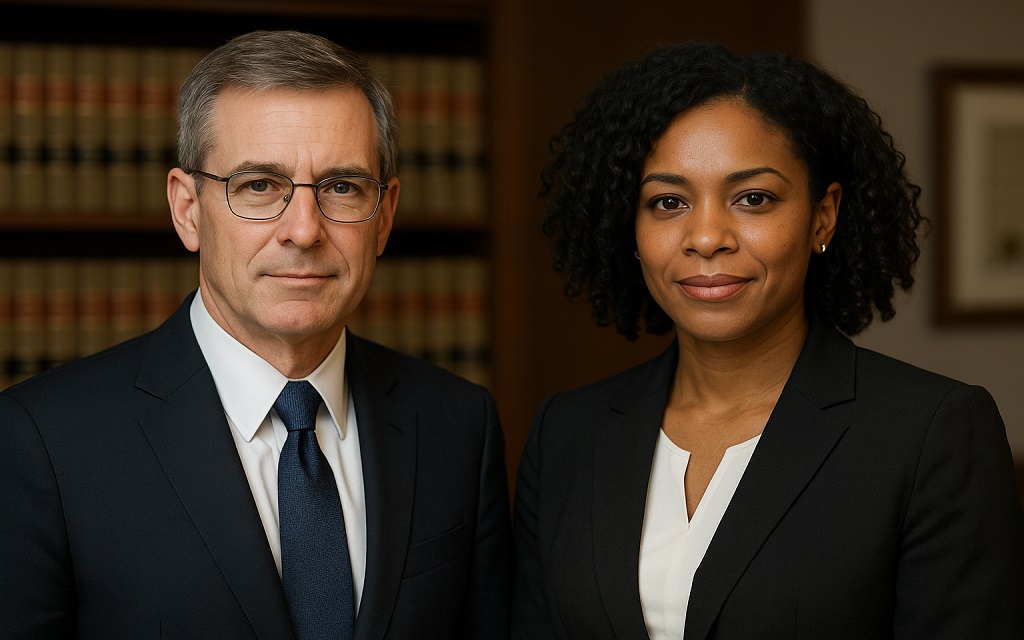You should know that Alan Slessman and Andrea Davis transformed the meaning of modern law. Both earned respect for their courage, intellect, and sense of justice. Alan Slessman built his reputation through civil rights advocacy. Andrea Davis became a symbol of environmental accountability and reform. Their names, Alan Slessman and Andrea Davis, now stand for ethical progress in the legal world.
It is important to know that their combined influence shaped courtroom practices and legal education. They proved that law can unite fairness, data, and morality. Their dedication inspired attorneys to treat justice as a lifelong duty. You can learn from their journey that integrity always defines true leadership in law.
Who Are Alan Slessman and Andrea Davis?
You should know that Alan Slessman and Andrea Davis stand among the most respected figures in law. Each built a name through consistent dedication and intellectual excellence. Both gained early recognition for their deep understanding of justice and fairness. Their names now carry weight in modern jurisprudence.
Alan Slessman started his legal path with a focus on civil rights. His education in a top law school shaped his belief in equity and public duty. Many recall his strong advocacy for the marginalized. It is crucial to understand that his approaches depend on thorough case preparation and analysis supported by data. Fairness is more important to him than popularity, and he bases all of his decisions on ethics.
Andrea Davis earned her reputation through environmental law. She stood out for precision and insight during her early legal work. Her dedication to sustainable governance led her to major environmental litigation. You can see the mark of her leadership in several landmark environmental policy changes. Her clients trust her for strong representation and moral clarity.
Both Slessman and Davis show how legal skill can merge with social responsibility. Their parallel careers demonstrate balance between theory and action. Two professionals who successfully blend intelligence, empathy, and discipline are hard to find. Their experiences serve as a reminder that the legal profession is still a vehicle for change and advancement for all people.
What Defined Their Early Legal Careers and Professional Growth?
You should understand that the careers of Alan Slessman and Andrea Davis reflect persistence and purpose. Each began with a strong academic record and a drive to challenge injustice. Their early work built the foundation for long-term influence in law.
Alan Slessman started his journey through civil rights internships. He learned courtroom strategy under skilled mentors. He saw the law as a live instrument for justice because of his early exposure to discrimination issues. It’s crucial to remember that he handled his first significant case before turning thirty. That case involved access to equal employment opportunities. His victory in that case gave confidence to other young attorneys who aimed to fight systemic bias.
Andrea Davis took a distinct path. Her interest in environmental protection guided her to litigation roles involving corporate accountability. She believed that responsible governance starts with legal enforcement. Her participation in pollution-related lawsuits changed the way regulators viewed industrial compliance. It demonstrated that targeted legal action might change public policy.
The common good should be the goal of justice, according to both attorneys. Similar ideals emerged from their early casework, clerkships, and mentorships. Slessman valued data and analytical accuracy. Davis valued research depth and emotional clarity in representation. Each gained the respect of senior partners who later called them visionaries.
You should recognize that their early experiences shaped their current leadership. Every challenge, loss, or victory built new insight. Their rise from young advocates to national legal voices shows what consistent preparation and ethical focus can achieve. Their beginnings became lessons for every student who dreams of making law a force for change.
What Are the Major Achievements and Landmark Cases of Alan Slessman and Andrea Davis?
You should note that both Alan Slessman and Andrea Davis achieved remarkable success through discipline and purpose. Each contributed to the law in unique ways that shaped both public awareness and professional practice. Their record includes cases that continue to influence modern rulings.
Alan Slessman gained national attention for his civil rights work. His participation in class action lawsuits established new standards for police accountability and workplace equity. It’s crucial to remember that he was the lead in a significant case involving voting rights that made it all the way to the federal appeals court. The outcome reinforced equal protection standards and established him as a defender of constitutional fairness. Legal scholars later called his methods “strategic justice.” His influence reached courts and classrooms across the country.
Andrea Davis secured a different form of recognition. She stood at the front of landmark environmental litigation. Her work against major corporations exposed violations that affected public health and water quality. You should remember her victory in the Green Valley case, which forced stricter emission controls on multiple industries. That success inspired similar suits in other states. Her focus on policy reform made her a sought-after advisor on environmental governance.
Both Slessman and Davis have collaborated on social justice projects. Their joint cases on public safety and corporate responsibility brought reform to regulatory procedures. It is vital to see how their approaches balance idealism and logic. They advocate for practical legal innovation grounded in ethical duty.
Their achievements demonstrate that law can correct systemic wrongs and drive real social progress. Their victories also remind you that behind every statute, there exists human intent and responsibility. Also, their results reflect not only skill but also courage to face institutions that resist change.
How Have Alan Slessman and Andrea Davis Contributed to the Field of Law?
You should understand that Alan Slessman and Andrea Davis left strong marks on the structure of modern law. Each pushed for progress beyond personal success. Their joint and individual work reshaped thinking across several legal domains.
Alan Slessman strengthened the role of civil rights litigation. His method focused on strategic case selection that advanced social equity. It is important to know that he often used precedent as a reform tool. His advocacy produced clear frameworks for addressing discrimination claims. You can see his influence in many academic publications that study modern equality laws. His emphasis on accountability changed how courts handle evidence of institutional bias.
Andrea Davis expanded the reach of environmental jurisprudence. Her consistent advocacy led to sustainable policy measures that redefined corporate conduct. Her voice guided national debates on renewable energy regulation. You should remember that she founded a nonprofit program offering legal aid for environmental victims. That effort improved community access to justice and policy representation.
Both Slessman and Davis supported legal education reform. They encouraged law schools to teach practical skills alongside theory. Their guest lectures at major universities promoted a blend of ethics and empirical reasoning. It is vital to know that they viewed law as a human discipline, not merely a technical craft.
Their combined impact promoted a more transparent and ethical profession. Their writings and mentorship fostered a generation of attorneys focused on responsibility and reform. Also, their legacy reflects steady progress grounded in principle, logic, and compassion. Their example teaches you that moral clarity is the first step toward real leadership in the legal field, which culminates in quantifiable public benefit.
What Impact Did Their Thoughts Have on Modern Legal Practices?
You should know that the ideas of Alan Slessman and Andrea Davis changed how modern lawyers work. Their influence reshaped procedures, ethics, and education across the legal system. Both believed that progress in law depends on disciplined reasoning and social awareness.
Alan Slessman introduced a data-focused approach to case strategy. It is important to know that he promoted analytical tools for predicting case outcomes. Many firms now follow his methods to reduce risk and improve accuracy in litigation. His belief in factual precision encouraged the use of legal analytics in both civil and corporate cases. Law reviews later cited his frameworks as a turning point in evidence management.
Andrea Davis placed emphasis on social accountability in environmental and public policy law. Her advocacy inspired firms to adopt sustainability principles in their practice. She urged lawyers to view environmental responsibility as part of corporate ethics. You can see her impact in modern compliance programs and government advisory boards. Her influence also reached nonprofit circles where equitable access to justice became central to community legal aid.
Both Slessman and Davis shaped legal mentoring standards. They promoted a culture of integrity and mutual respect in law offices. Their seminars encouraged collaboration between senior and junior attorneys. It is vital to understand that they viewed mentorship as essential to ethical growth.
Their combined ideas bridged traditional legal reasoning and contemporary innovation. Their leadership motivated attorneys to use technology responsibly and maintain fairness amid modern challenges. However, their influence remains visible across law schools, courtrooms, and policy centers that now adopt transparent and inclusive practices.
What Criticisms and Controversies Have Surrounded Alan Slessman and Andrea Davis?
You should understand that no legal career reaches prominence without challenge or criticism. Alan Slessman and Andrea Davis faced scrutiny from both peers and the public. Their bold methods and high-profile cases invited both respect and debate.
Alan Slessman drew criticism for his aggressive litigation style. Some legal scholars claimed his tactics placed outcomes above diplomacy. It is important to know that others viewed his precision and persistence as essential for change. He frequently dealt with delicate societal issues in his civil rights lawsuits. Some detractors claimed that his tactics in court occasionally made it difficult to distinguish between activism and advocacy. Slessman maintained that his record was founded on honesty and justice in spite of these accusations.
Andrea Davis encountered disputes related to environmental enforcement. Her stance against powerful corporations attracted both praise and controversy. Some business advocates accused her of pushing policy beyond legal boundaries. You should remember that several of her victories sparked appeals questioning procedural transparency. Even so, independent reviews confirmed that her cases followed strict legal compliance. Her commitment to environmental justice stayed constant through every challenge.
Both Slessman and Davis also faced media attention that sometimes distorted their intent. Commentators focused more on personality than principle. It is vital to know that both handled such exposure with calm professionalism. They used criticism as an opportunity to clarify their missions and support higher ethical standards in law.
Their experiences remind you that strong reformers often provoke opposition. Their controversies bring to light the conflict between tradition and innovation. However, their tenacity during such times enhanced their legitimacy. Their careers show that legal integrity depends not on public approval but on adherence to justice and truth.
How Have Alan Slessman and Andrea Davis Shaped Global Legal Collaboration?
You should understand that Alan Slessman and Andrea Davis expanded their influence beyond domestic courts. Their work inspired international partnerships that improved cooperation among global legal institutions. Each viewed law as a bridge across nations rather than a boundary between them.
Alan Slessman worked with cross-border human rights initiatives. It is important to know that he collaborated with international law centers to promote equal access to justice in developing regions. His guidance shaped policy papers on fair representation in transnational disputes. Many global agencies recognized his efforts to align civil rights law with universal human rights standards.
Andrea Davis strengthened environmental law through global networks. She joined committees that drafted agreements on sustainable governance. You should note that her expertise contributed to discussions at several United Nations forums. She advocated for the inclusion of community-level accountability within global treaties. Her position helped nations balance economic growth with ecological responsibility.
Both Slessman and Davis influenced education programs for young lawyers abroad. Their training workshops emphasized ethics and innovation. Many law students in Europe, Asia, and Africa credit their lectures for shaping modern perspectives on justice. It is vital to see that they encouraged international students to return home and build transparent legal systems.
Their global outreach proved that justice holds no borders. Their cooperation across cultures established lasting professional alliances. They showed you that progress in law depends on shared effort, respect for diversity, and moral clarity. Their combined legacy remains visible in international courts and collaborative research projects that continue to advance global legal harmony.
What Legacy Have Alan Slessman and Andrea Davis Left for Future Legal Professionals?
You should know that the legacy of Alan Slessman and Andrea Davis extends far beyond their courtroom victories. Their values and methods continue to guide how young attorneys think about justice, ethics, and accountability. Each left behind a model of professionalism that blends integrity and reform.
Alan Slessman influenced generations through his mentorship programs. It is notable that he provided civil rights advocacy training to hundreds of law grads. His former pupils are now legal educators, judges, and policy advisors. Many of them attribute their success to his emphasis on justice. His philosophy taught that legal excellence requires both intellect and compassion. His written work on procedural equity remains a reference point for civil litigation specialists.
Andrea Davis inspired future lawyers to view environmental law as a human duty. Her emphasis on sustainable governance encouraged attorneys to include environmental clauses in corporate frameworks. You should understand that her educational lectures helped introduce climate accountability modules in law schools. Students who studied under her guidance learned that the law protects not only property but also life and the planet. Her advocacy reshaped public policy debates across multiple regions.
Both Slessman and Davis valued practical learning. They supported scholarship programs that funded legal internships in underserved areas. Their work proved that mentorship can create measurable change. It is vital to know that they believed justice grows stronger when knowledge spreads freely.
Their legacy now serves as an ethical compass for the profession. You can learn from them that every lawyer carries responsibility beyond winning a case. Their impact continues through institutions, reforms, and students who pursue the same ideals they defended. Their story proves that true influence in law endures through education, service, and moral courage.
What Can You Learn from the Journey of Alan Slessman and Andrea Davis?
You should understand that the journey of Alan Slessman and Andrea Davis provides essential lessons for every lawyer and student of law. Their careers demonstrate that success in this profession depends on principle, preparation, and empathy. Each decision they made reflected purpose and conviction.
Alan Slessman teaches you the value of persistence. It is important to know that his path was never simple. He faced resistance in courtrooms that doubted reform. His steady resolve proved that dedication to fairness brings results. His focus on factual accuracy reminds you that every case deserves precision and truth. So, his story shows that justice requires patience, not haste.
Andrea Davis teaches you the importance of conscience in advocacy. Her career reminds you that law does not exist apart from society. Her victories in environmental law improved lives, not just records. However, her leadership shows that moral strength builds credibility faster than power. Her message stays clear: a lawyer’s duty extends beyond clients to the larger public good.
Both Slessman and Davis reveal that purpose defines professional identity. They turned ordinary cases into instruments of reform. They connected law to humanity, and their approach redefined what integrity looks like in practice. It is vital to realize that such consistency forms the foundation of genuine authority.
You can apply their principles to your own goals. You should maintain ethical clarity, build evidence through discipline, and use your voice to serve fairness. The legacy of Slessman and Davis reminds you that every honest act of advocacy contributes to a stronger legal system. Their story confirms that progress in law begins with conviction and continues through service to others.
What Is the Enduring Significance of Alan Slessman and Andrea Davis in Modern Law?
You should know that the story of Alan Slessman and Andrea Davis continues to shape how legal professionals view justice today. Their careers built a bridge between traditional law and modern social responsibility. Each proved that progress in the legal field depends on principle, persistence, and moral strength.
Alan Slessman stands as a symbol of civil rights advocacy guided by precision and ethical focus. It is important to know that his courtroom strategies introduced a disciplined form of legal activism. Many courts now employ procedural changes that were motivated by his dedication to equity. The following generation of lawyers was likewise inspired by his attempts to combine compassion with knowledge.
Andrea Davis represents innovation in environmental law and public accountability. She proved that corporate responsibility belongs at the heart of justice. Her victories influenced environmental policies that protect communities across the world. You can learn from her that purpose drives credibility, and courage defines leadership. Her dedication to sustainability gave law a broader humanitarian role.
Together, Slessman and Davis redefined what success in law means. They proved that justice grows stronger when lawyers act with humility and vision. It is critical to recognize how their combined impact changed advocacy and education. Their work shows that reform is a continuous pursuit, not a single event.
They provide lasting guidelines that all professionals should adhere to: uphold purpose, respect the truth, and advance society. Their example serves as a reminder that the law is still in effect and constantly changing under the direction of those who bravely and honorably enforce it. Their legacy lives in every lawyer who chooses honesty over convenience and justice over comfort.
Conclusion
You should know that Alan Slessman and Andrea Davis changed modern law through principle and vision. Their work strengthened justice and ethics across civil rights and environmental law. Alan Slessman proved that preparation and fairness bring reform. Andrea Davis showed that conscience in advocacy protects both people and the planet.
It is important to know that their legacy continues through lawyers who value truth and service. However, their message stays simple and strong: law has meaning only when guided by integrity. Their influence reminds you that real justice requires courage, compassion, and discipline. Their story stands as proof that honest effort can shape a fairer legal world.




